Light and fluffy gnocchi recipe? You’re in the right spot! Learn how to make fresh homemade potato gnocchi with just 4 ingredients and simple step-by-step instructions. My secret is Yukon Gold potatoes, egg yolk (only) and fine milled Tipo 00 flour for best texture and flavor.
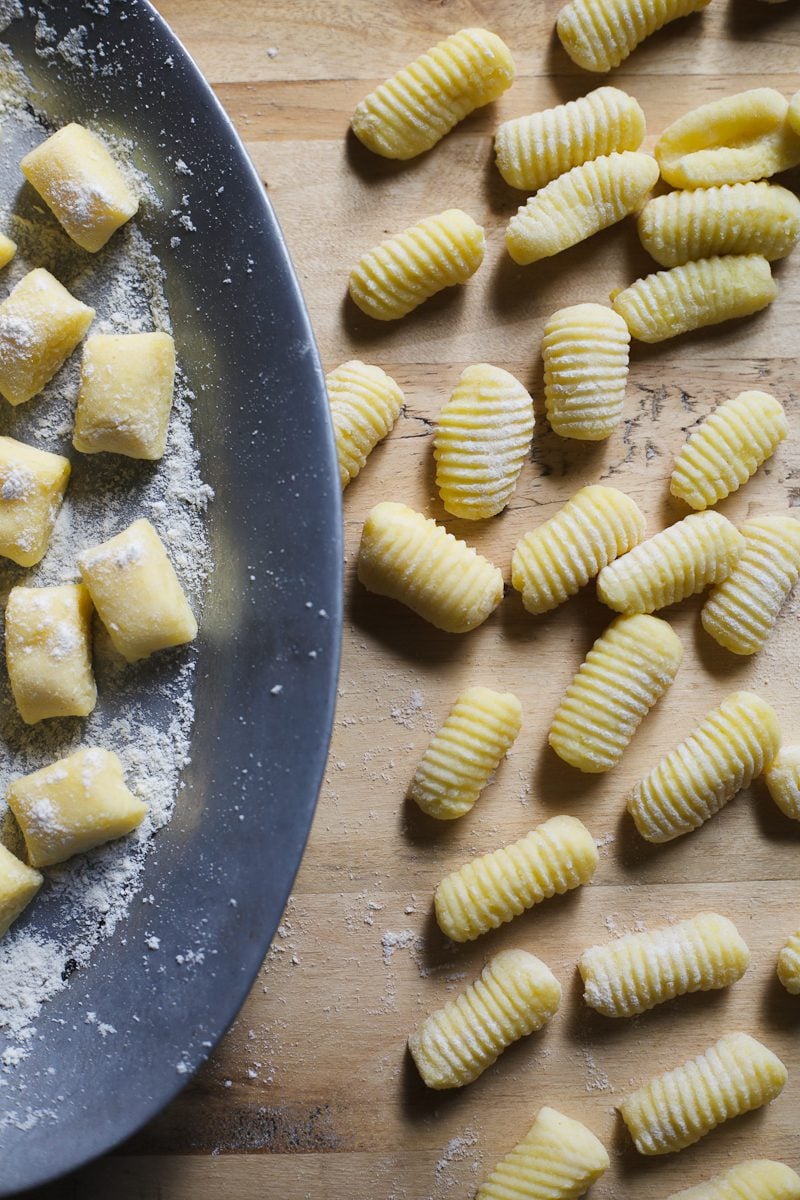
Admittedly, my first attempts at homemade gnocchi were futile. They weren’t dense like little bricks (a common problem). They were chewy, annoyingly so, and not in a sturdy toothsome kind of way. The defeat was crippling. What about those pillowy-soft clouds everyone raves about?!
To achieve gnocchi bliss, I needed to fail… and continue to fail until something clicked. Just like making sourdough bread or fresh homemade pasta, I learned homemade gnocchi was not just a recipe; it was an understanding. More specifically, an understanding of ingredients, how they worked together and what the dough should look and feel like.
My beginner’s guide will teach you everything you need to know about making fresh homemade gnocchi, from choosing the best potatoes, the right flour, understanding eggs (oh the controversy!) and how to avoid the dreaded dense and chewy gnocchi, so you too, can achieve light and fluffy etherial clouds!
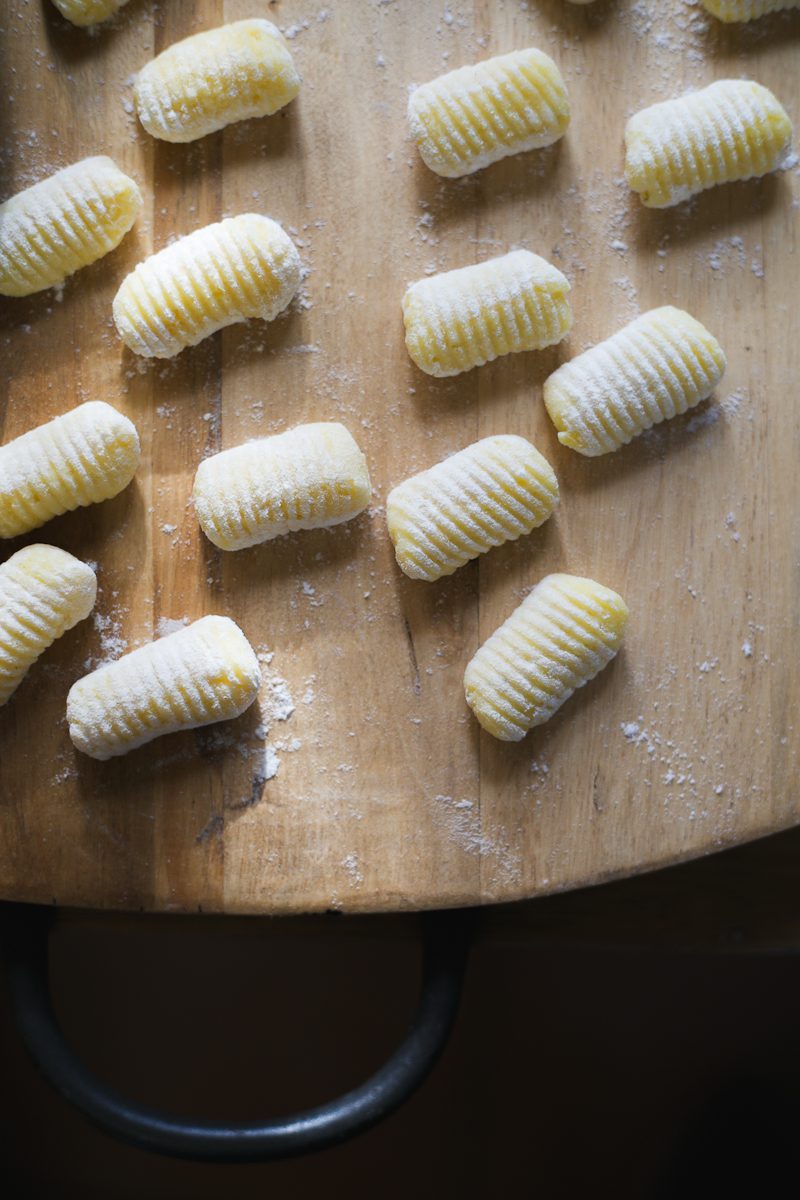
First, a Definition: What is Gnocchi?
Gnocchi (pronounced noh-kee or n’yaw-kee depending on where you’re from) translates to “little lumps” in Italian. From a culinary perspective, these lumps refer to small bits of dough. Gnocchi dough can be made from potato, semolina flour or ricotta cheese. However, potato gnocchi is the most common type. It’s made from cooked potatoes, a bit of flour and eggs (sometimes).
Is Gnocchi Pasta?
Technically no. Although often associated together, potato gnocchi are considered dumplings and not pasta because they are made primarily of potato (and not flour).
Understanding Eggs: The Great Debate
In your gnocchi recipe research you’ll come across two types of gnocchi: with eggs or without. This used to drive me nuts. But it’s important to understand. Here’s the deal: eggs are binders. They hold the dough together and prevent the gnocchi from dissolving into smithereens when cooked in rapid boiling water- this is huge.
But oftentimes, whole eggs yield dense and chewy gnocchi (this is from the egg white), which is why some gnocchi purists avoid them altogether. The problem is, if you go completely eggless the gnocchi become notoriously difficult to work with. The solution? Use egg yolks only (I learned this tip from Gennaro Contaldo on YouTube- he’s so funny!).
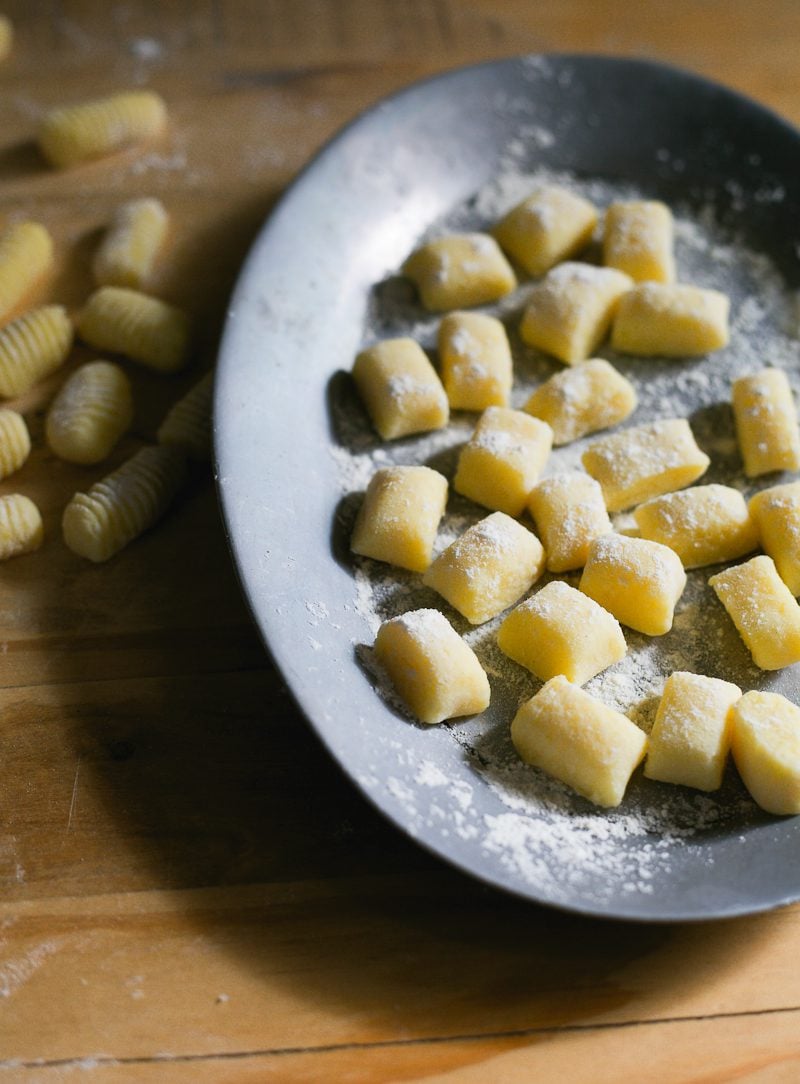
Why This Recipe Works {My Best Gnocchi Tips!}
- Egg Yolks (only) bind the dough together without the chewiness from whole eggs. The gnocchi becomes light, tender and a beautiful golden color.
- Yukon Gold Potatoes are THE BEST potatoes for homemade gnocchi. They’re dense, creamy, semi-waxy and do not retain too much moisture (if you love Yukon’s for mashed potatoes, they make exquisite gnocchi). Some gnocchi recipes recommend floury potatoes instead, such as Idaho potatoes or Russet potatoes, but I don’t always agree. They’re too mealy.
- Tipo 00 Flour is a soft, fine milled flour from Italy. It’s a must-have for light and tender gnocchi and homemade pasta.
- Small(er) Batch Recipe ensures a higher success rate with just enough practice.
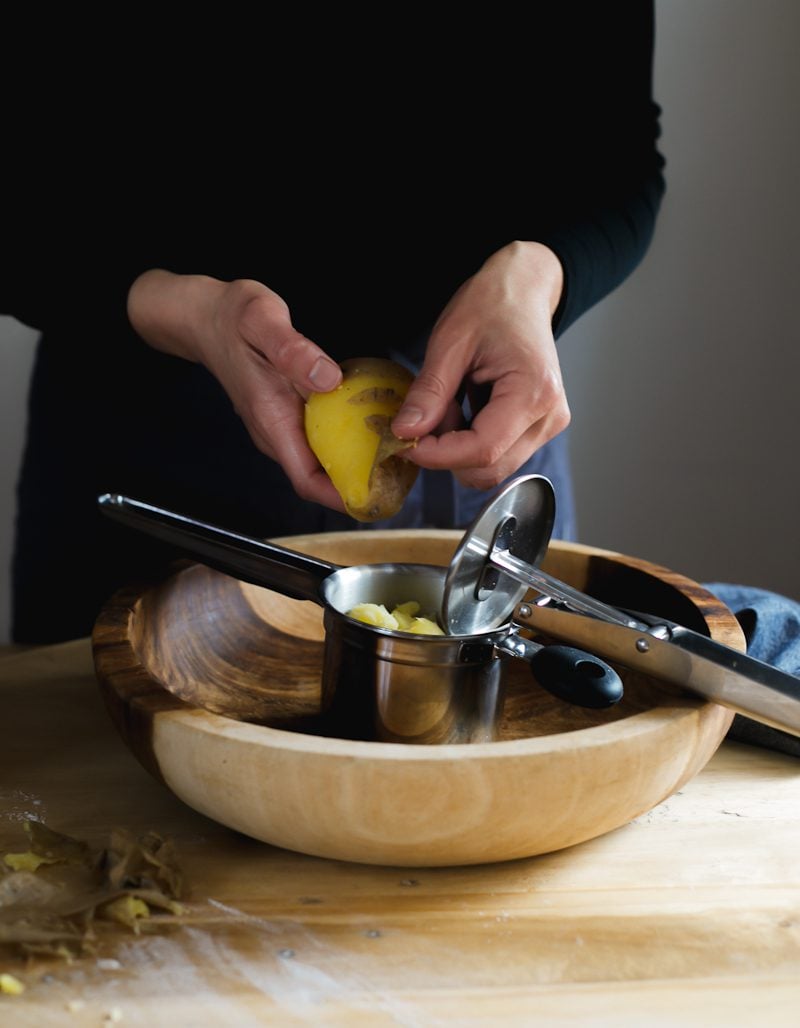
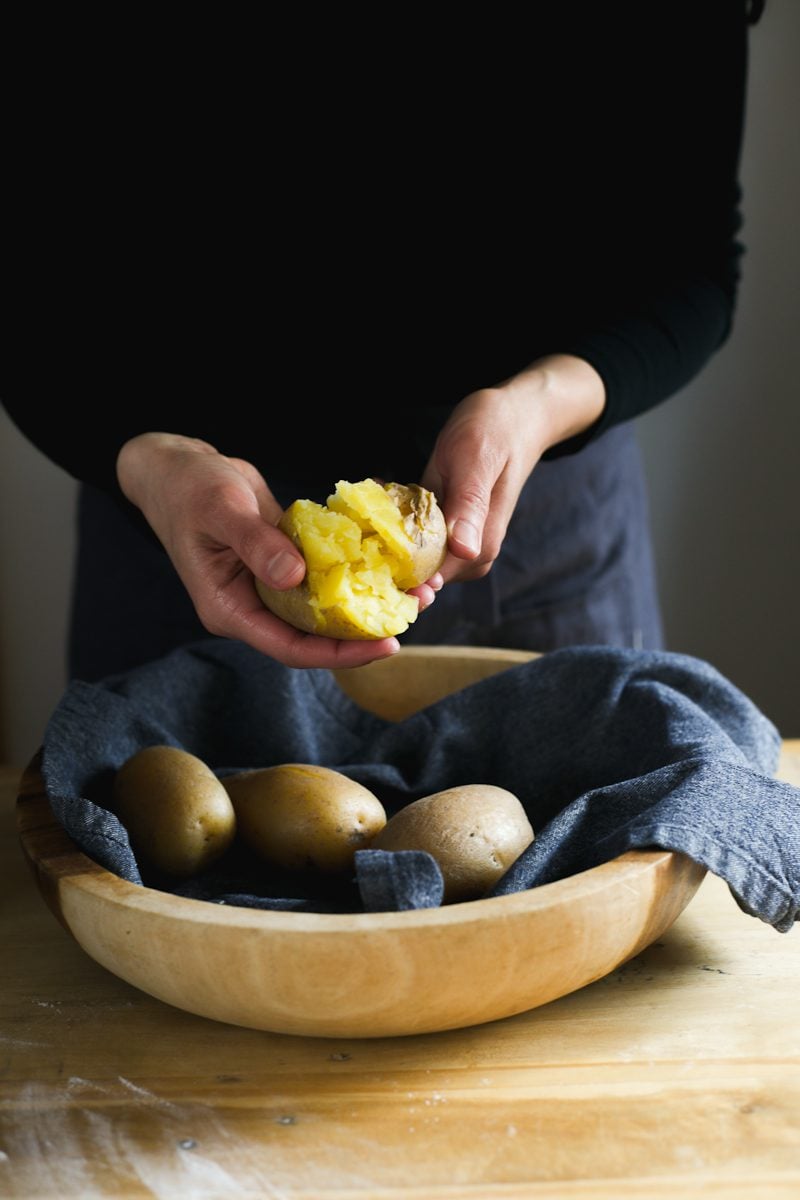
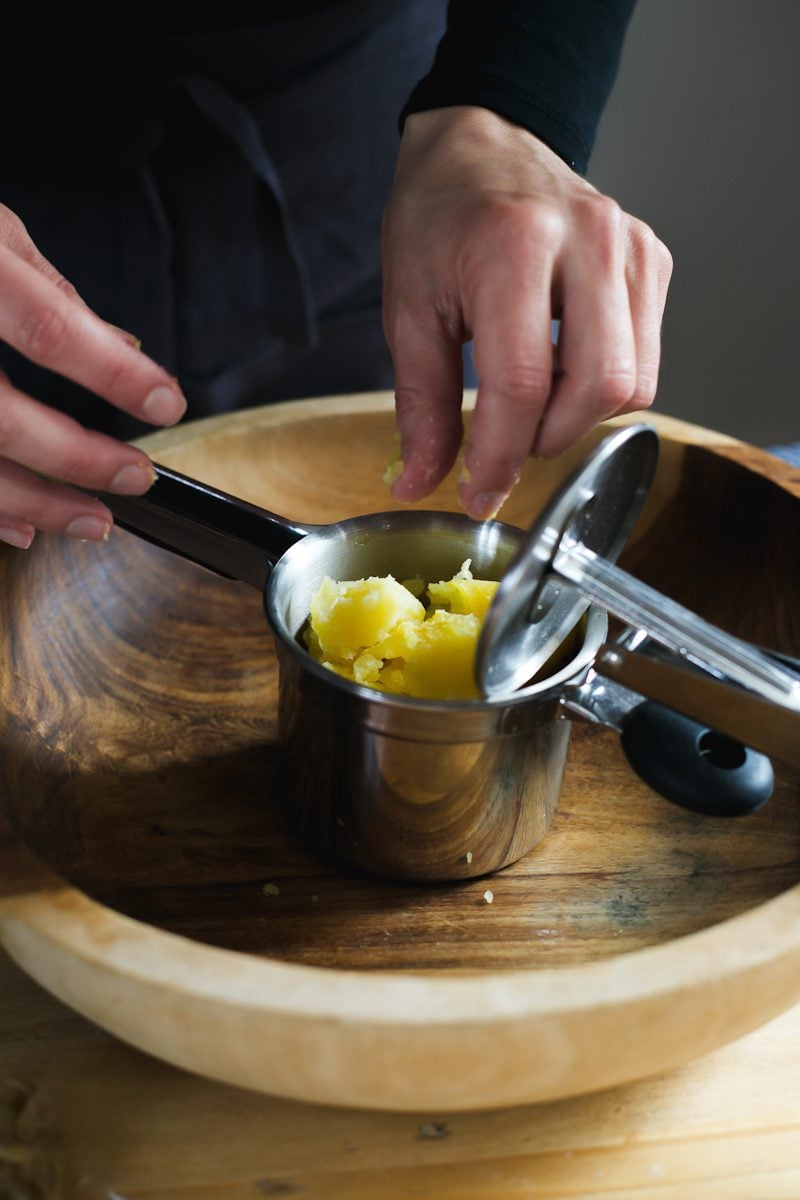
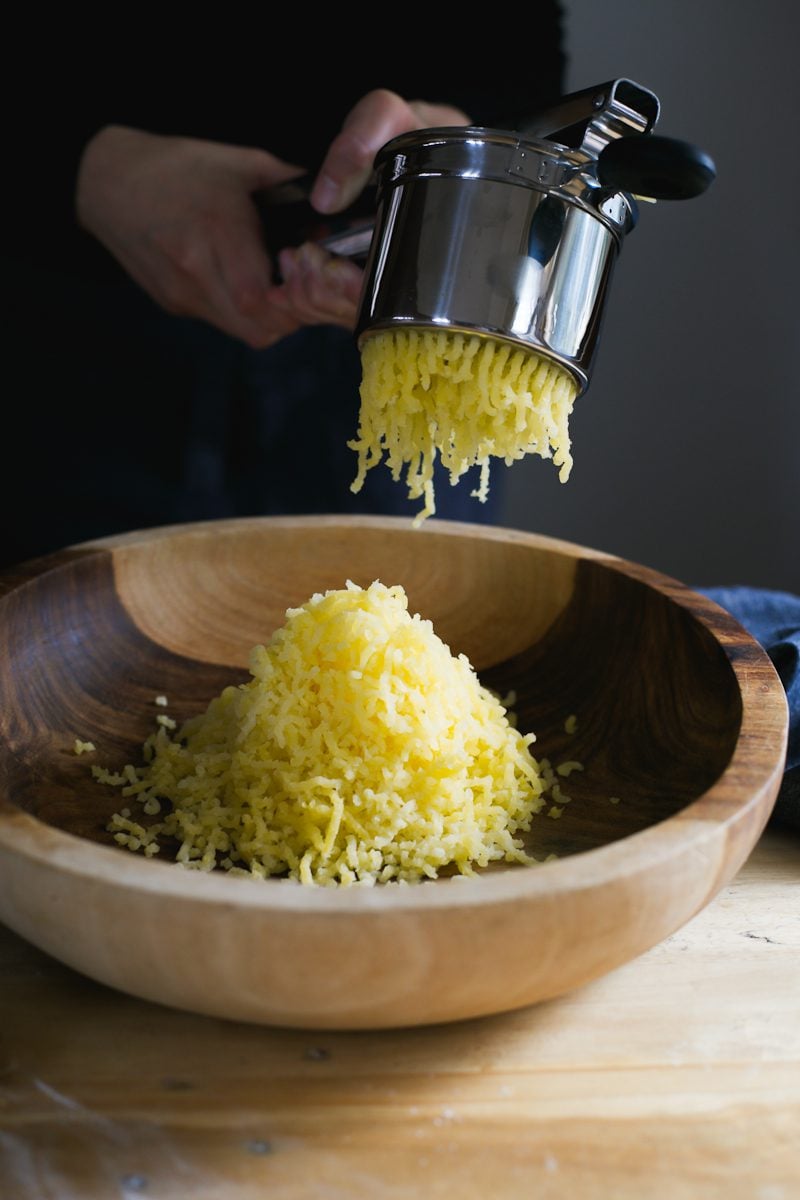
How To Make Fresh Homemade Potato Gnocchi {Step-by-Step}
Gnocchi Ingredients You Will Need:
- Yukon Gold Potatoes
- Egg yolk
- Fine sea salt
- Tipo 00 Flour
- Semolina flour, for dusting
- Potato Ricer
- Gnocchi Board (optional)
Step #1: Cook The Potatoes
- Boil the potatoes, skin on, until tender, about 25 minutes. Drain and dry thoroughly.
- Once cool enough to handle, but still warm (not hot), remove the skin.
- Rice the potatoes directly over a large, wide bowl. I use a wooden fruit bowl.
Tip: What is a Potato Ricer? It’s a useful kitchen gadget that passes cooked potatoes through small little holes. It makes the potatoes lump free, which is the ideal texture for light and fluffy gnocchi and mashed potatoes. Alternatively, use a food mill of mash gently with a fork.
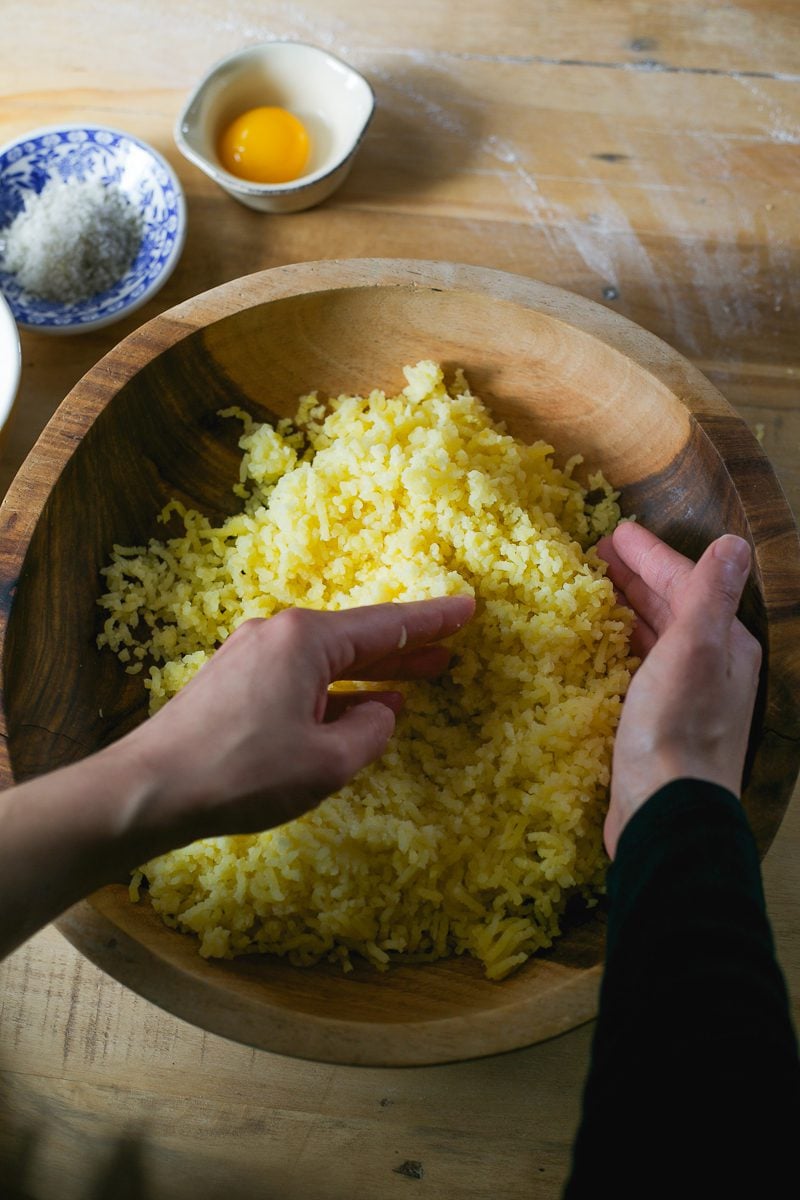
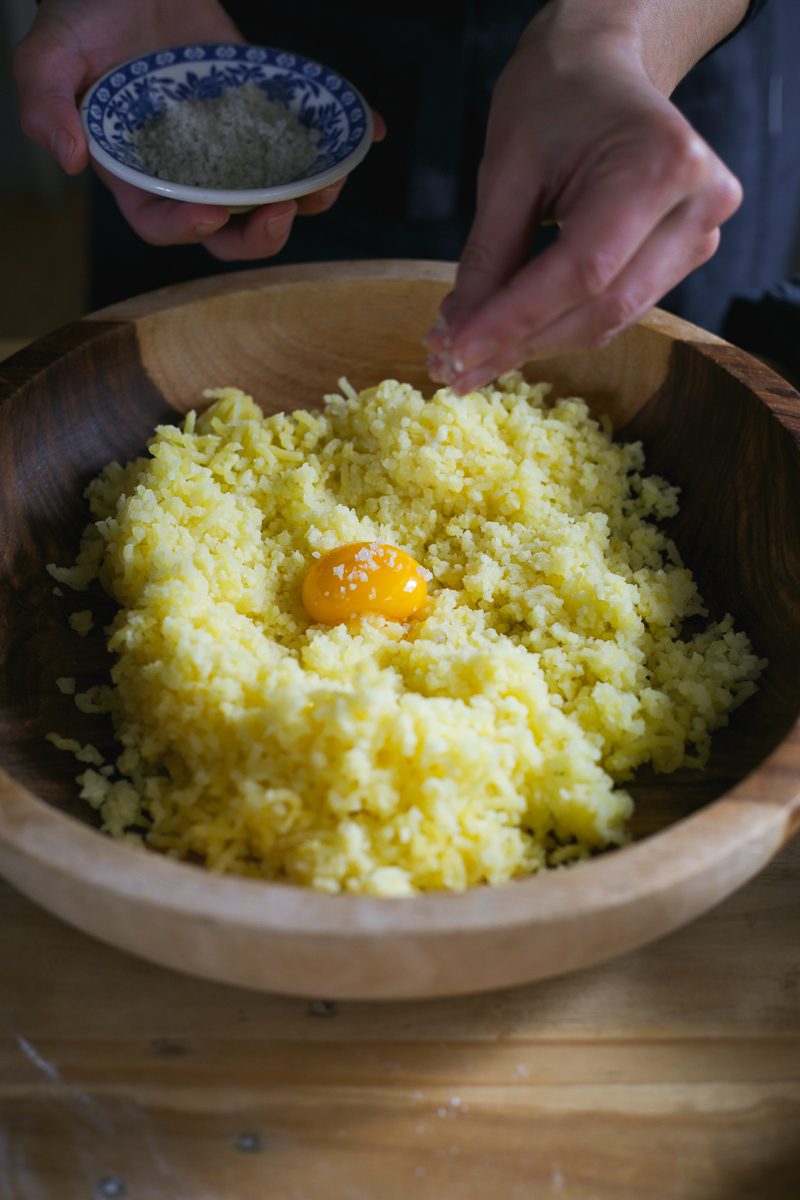
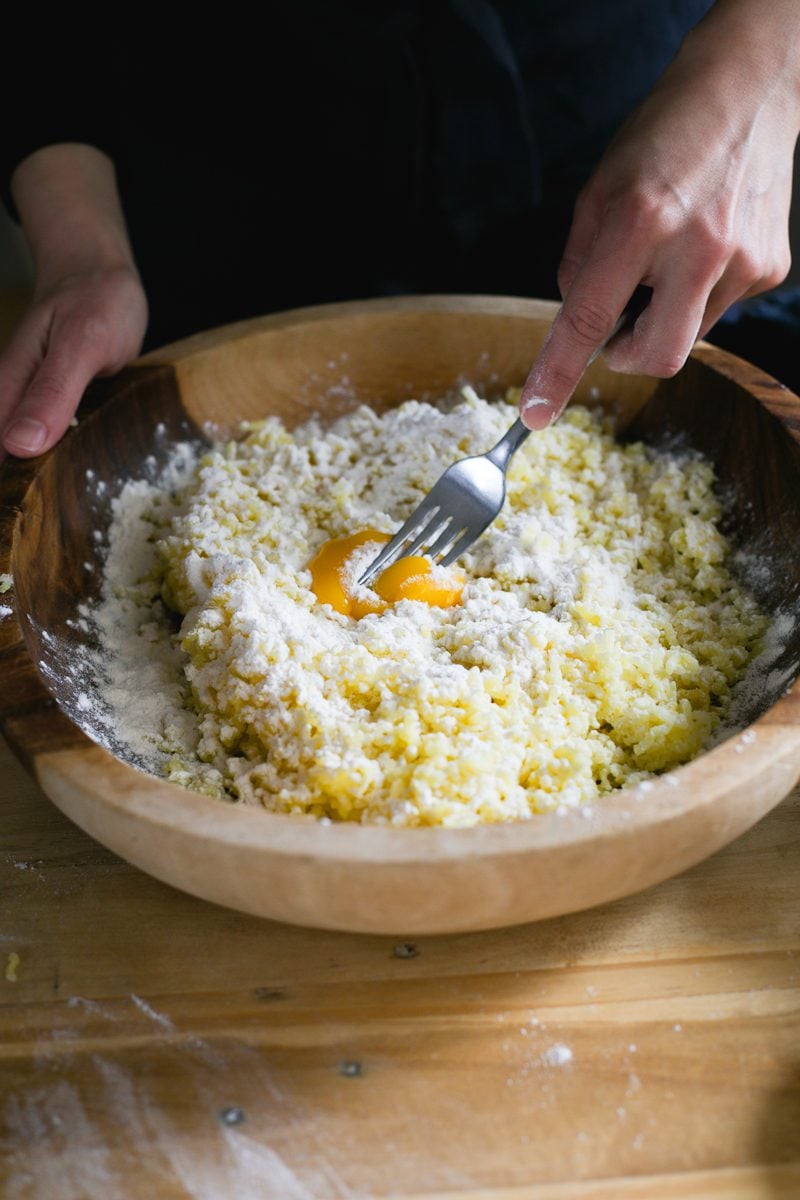
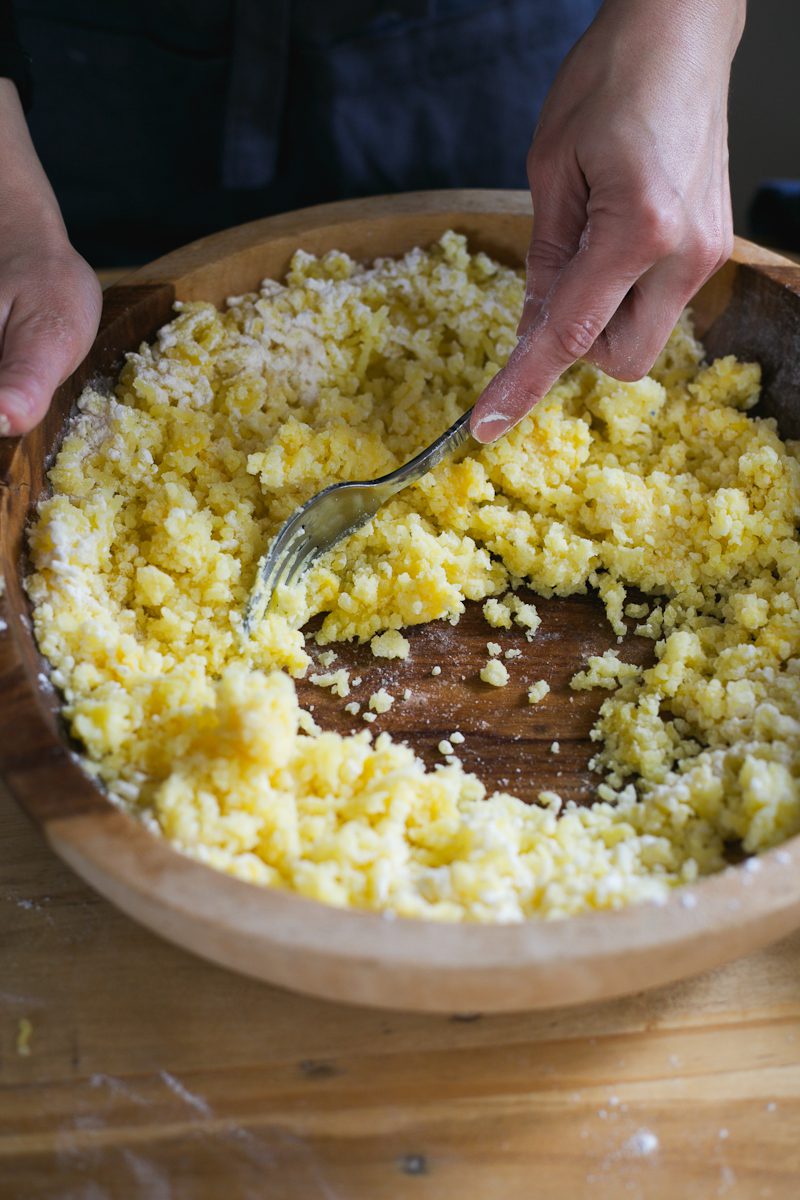
Step #2: Mix the Dough
- Form a “well” in the center of the potatoes. Add the egg yolk, salt and sprinkle some of the flour on top. Gently mix a few times with a fork, gradually adding the rest of the flour as you go. Once the dough starts to stick together (but is not yet a ball) stop. You’re going to finish by hand.
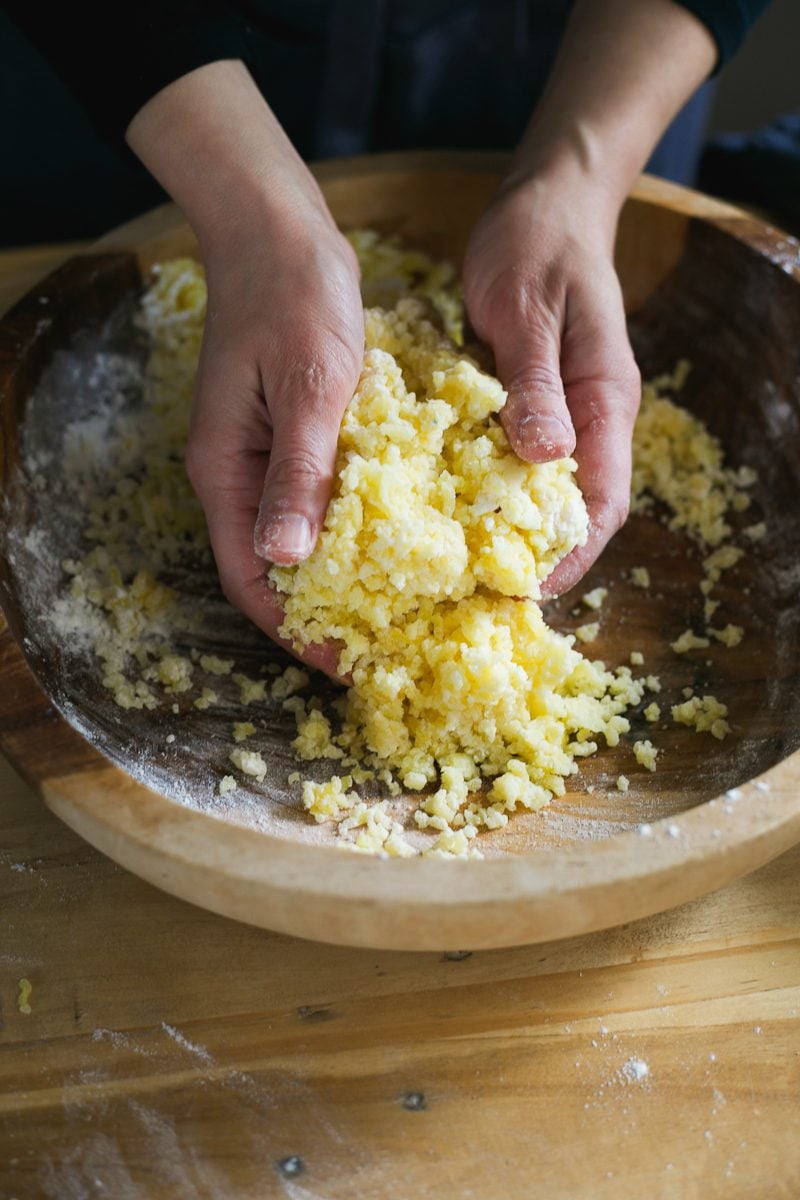
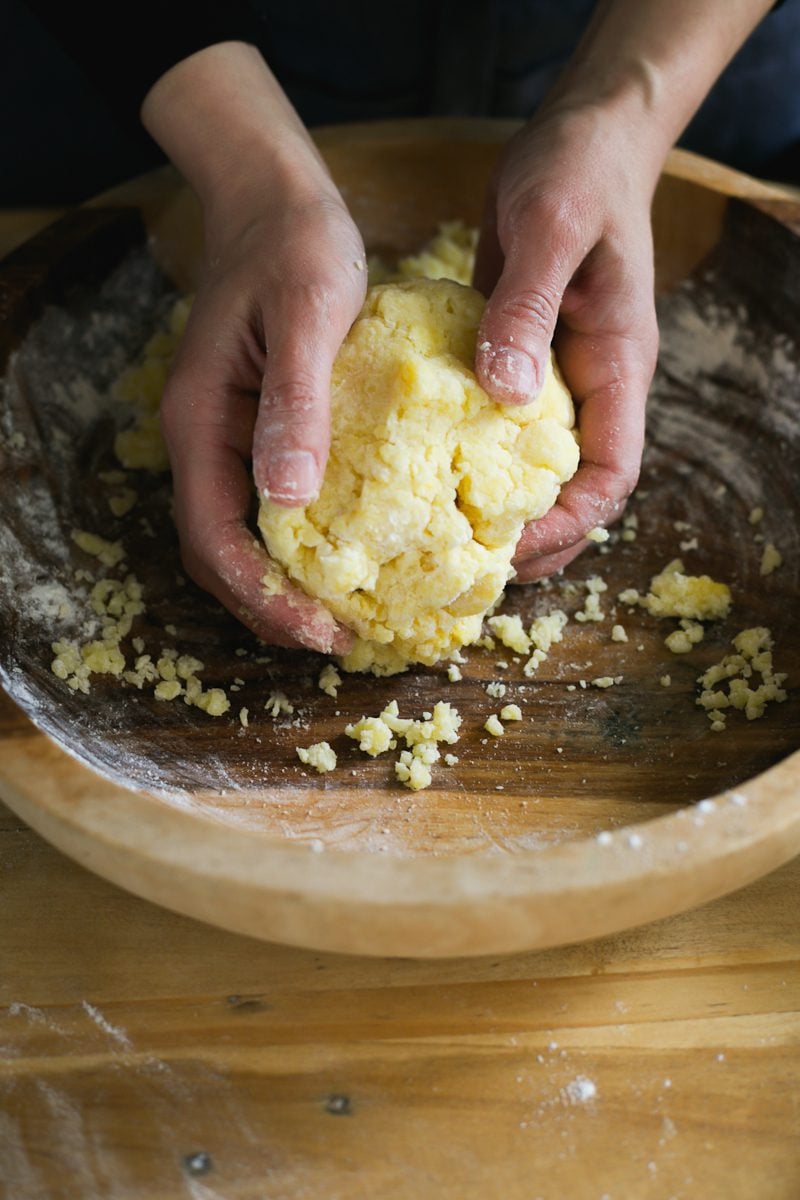
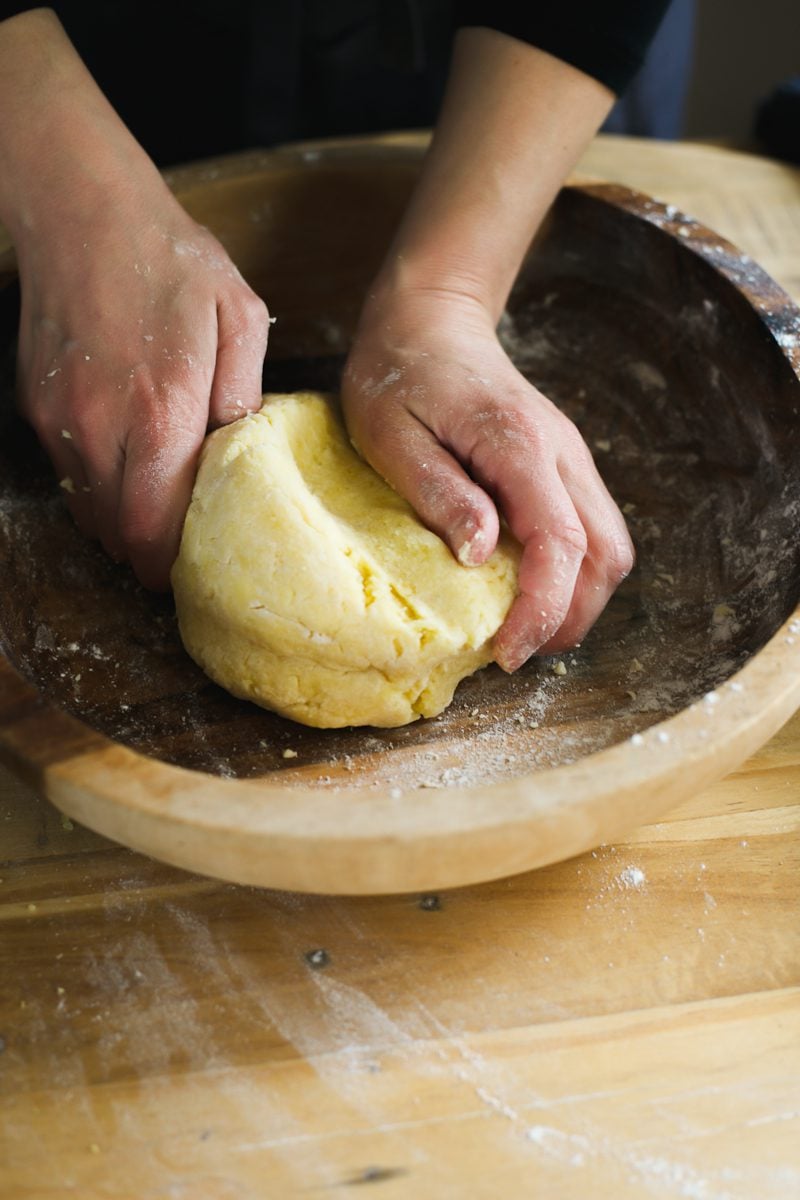
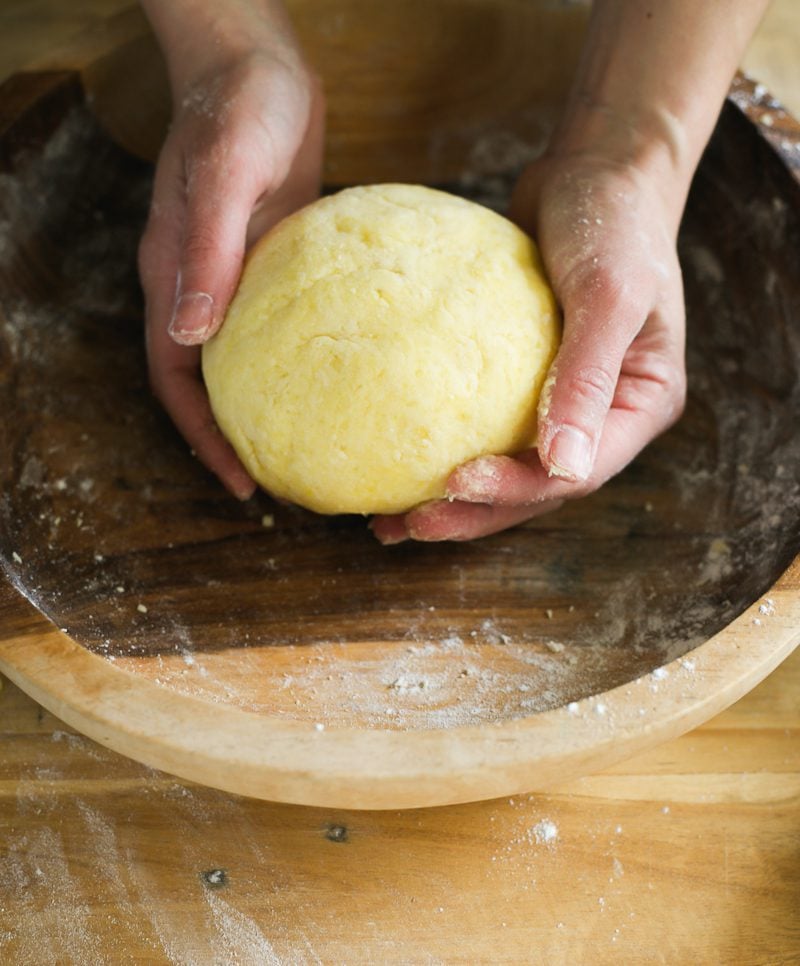
Mix the Dough (Cont.)
- Gently bring the dough together to form a cohesive ball. You do not need to “work” the dough (this is not pasta or bread dough). The texture should feel warm, light, fluffy and smooth, like a giant mashed potato ball.
- Cover and let rest for 10 minutes.
Tip: How to avoid dense and chewy gnocchi? Most gnocchi recipes insist chewiness comes from overworked dough, which is only partially true. This is actually difficult to achieve by hand unless you’re intentionally manhandling it, which over develops the gluten (and makes the potatoes gummy.) The chewiness usually comes from adding too much flour if the dough is sticky and/or using whole eggs.
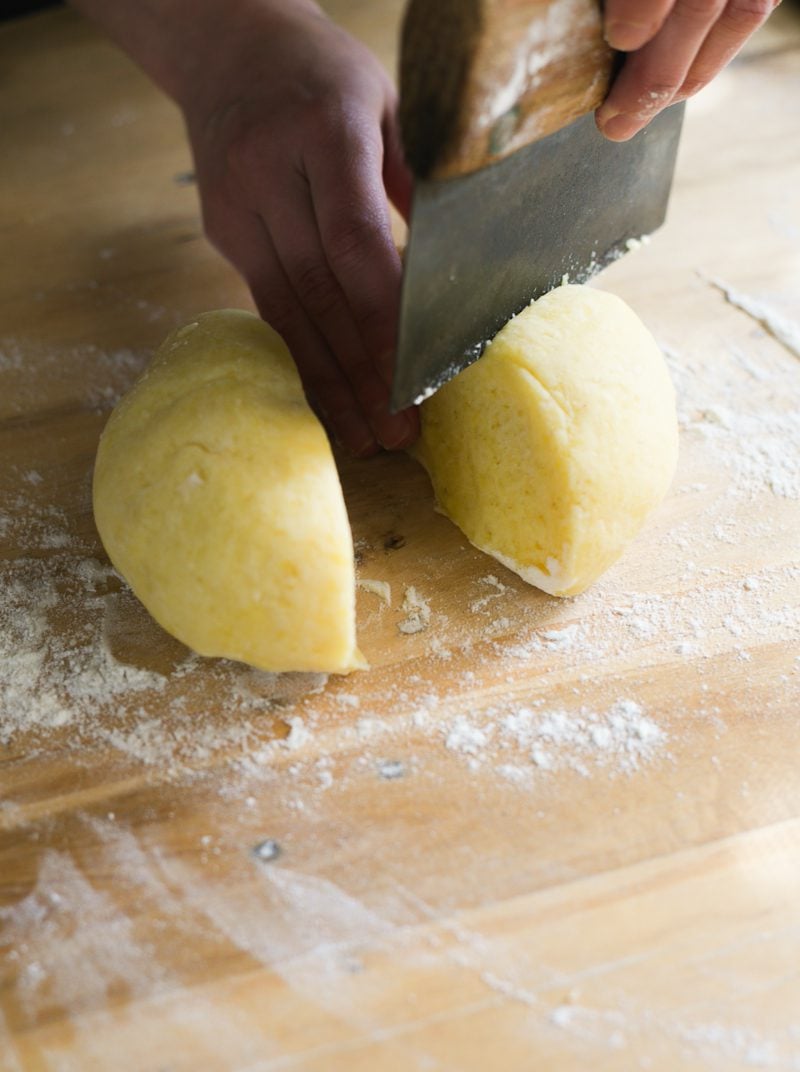
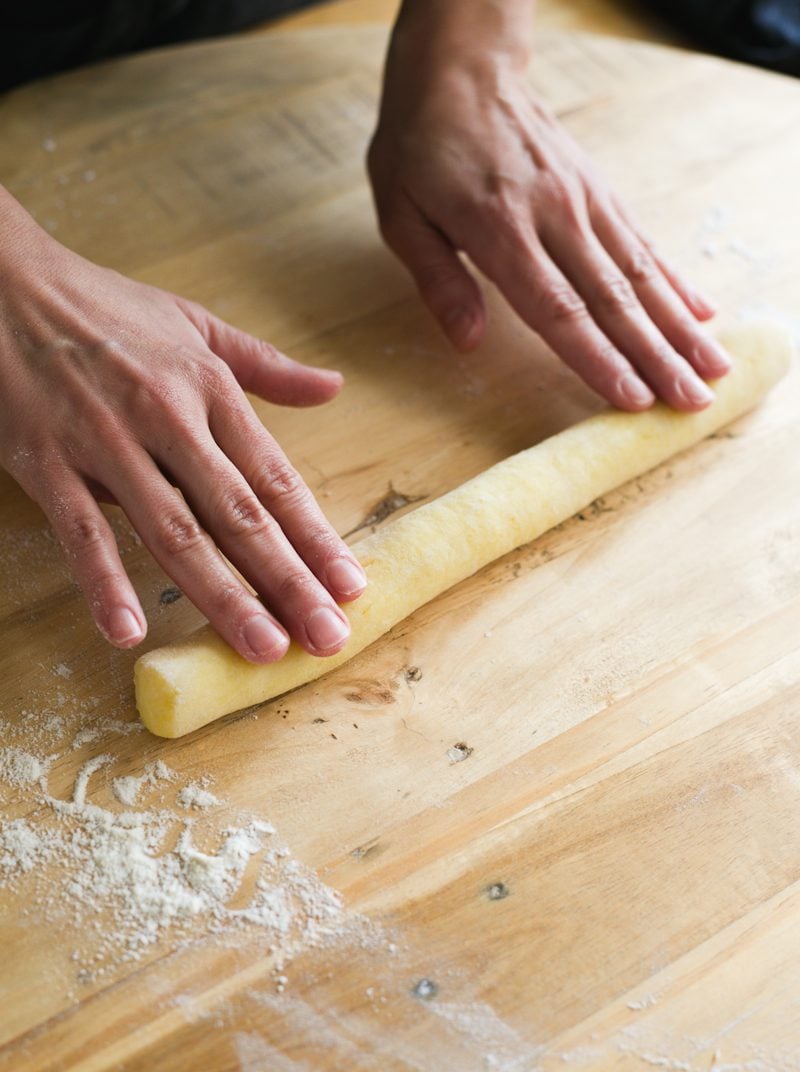
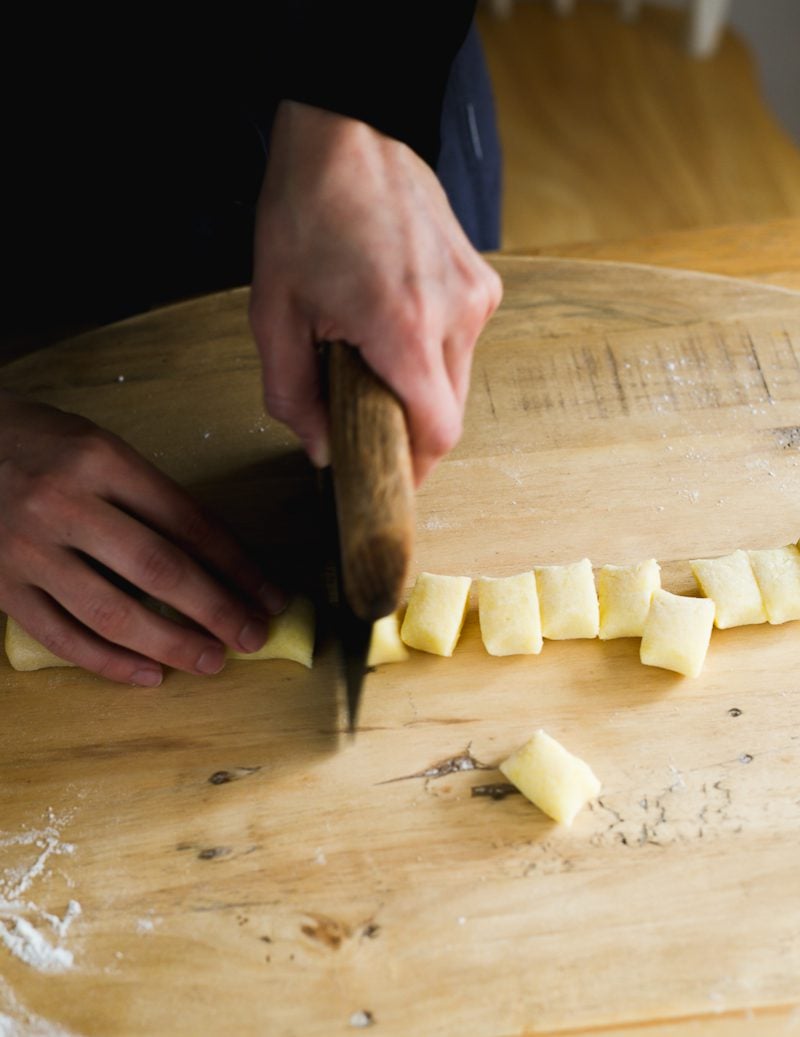
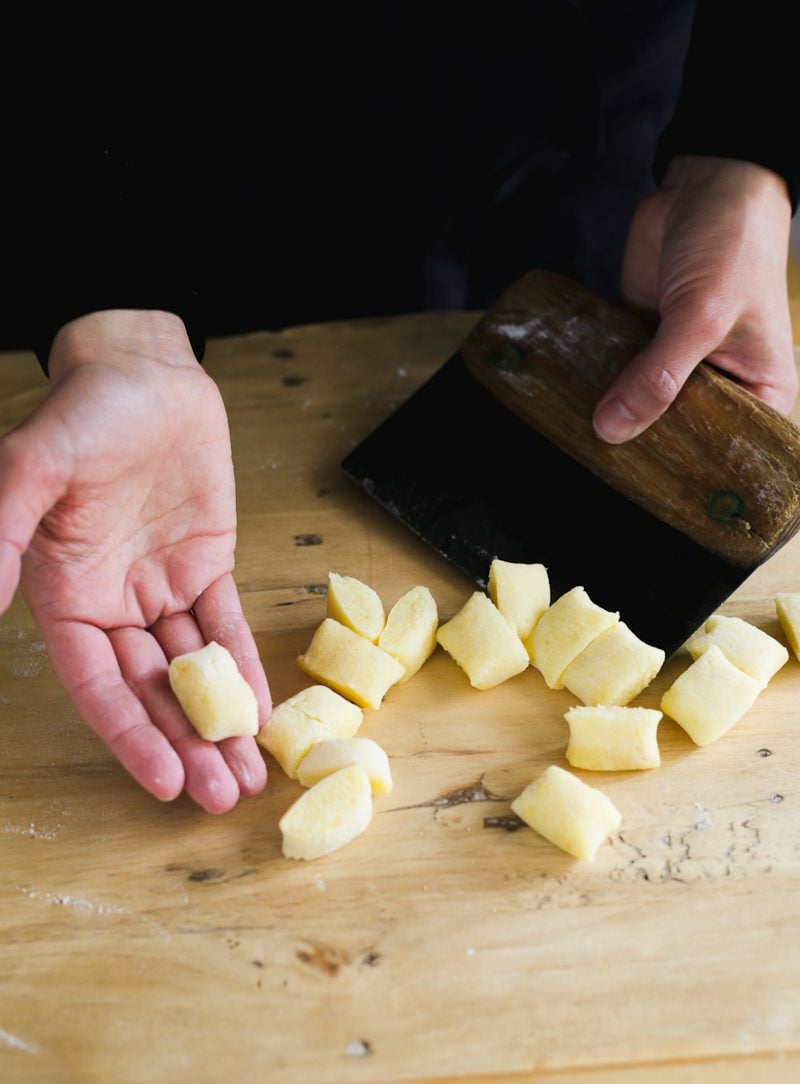
Step #3: Make Gnocchi!
- Cut the dough ball into 4 equal pieces.
- Roll one piece into a 10-12 inch (25-30 cm) log.
- Cut across into 20-22 gnocchi, about 1/2-inch (1.25 cm) in size to create little “pillows.”
- Transfer to a sheet pan dusted in semolina flour to prevent sticking. Repeat with the remaining pieces.
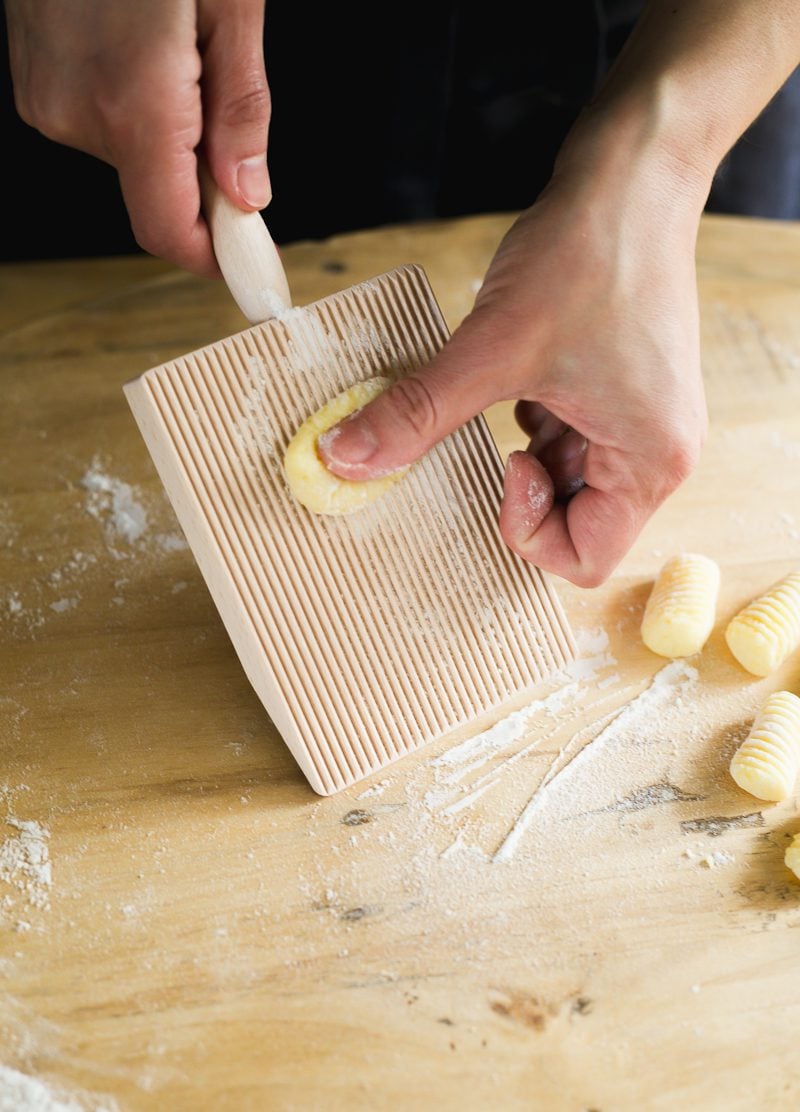
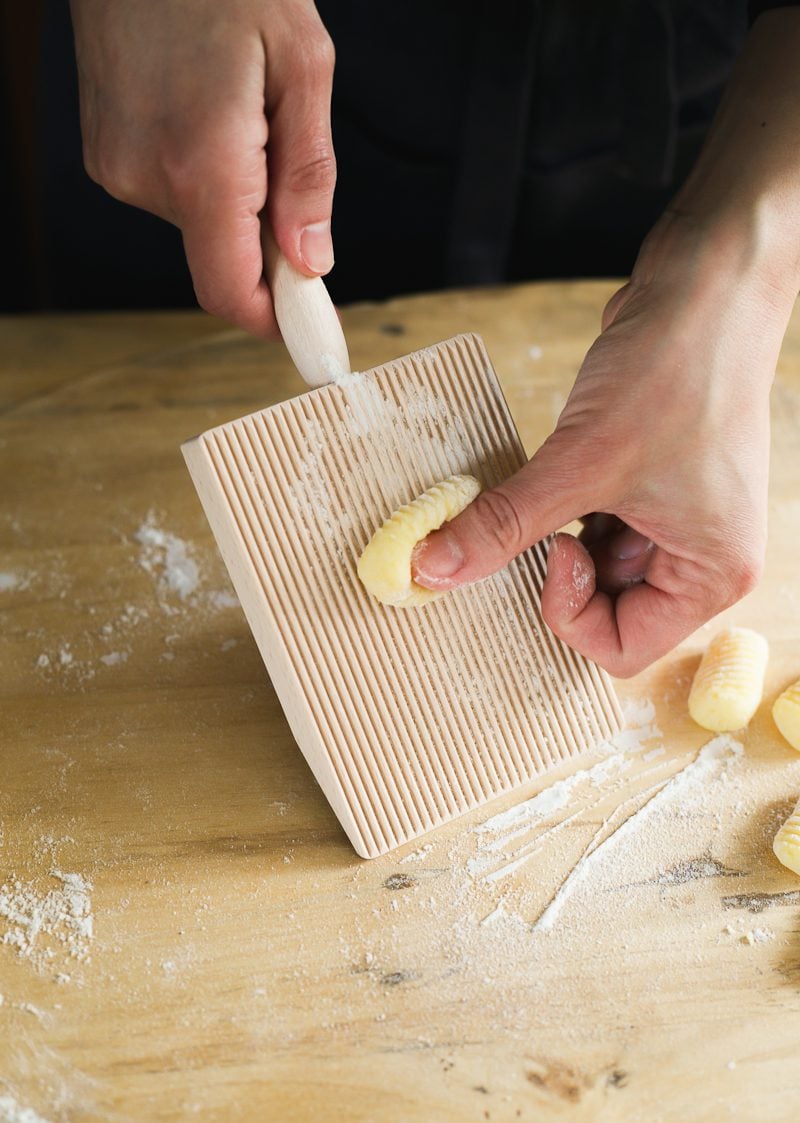
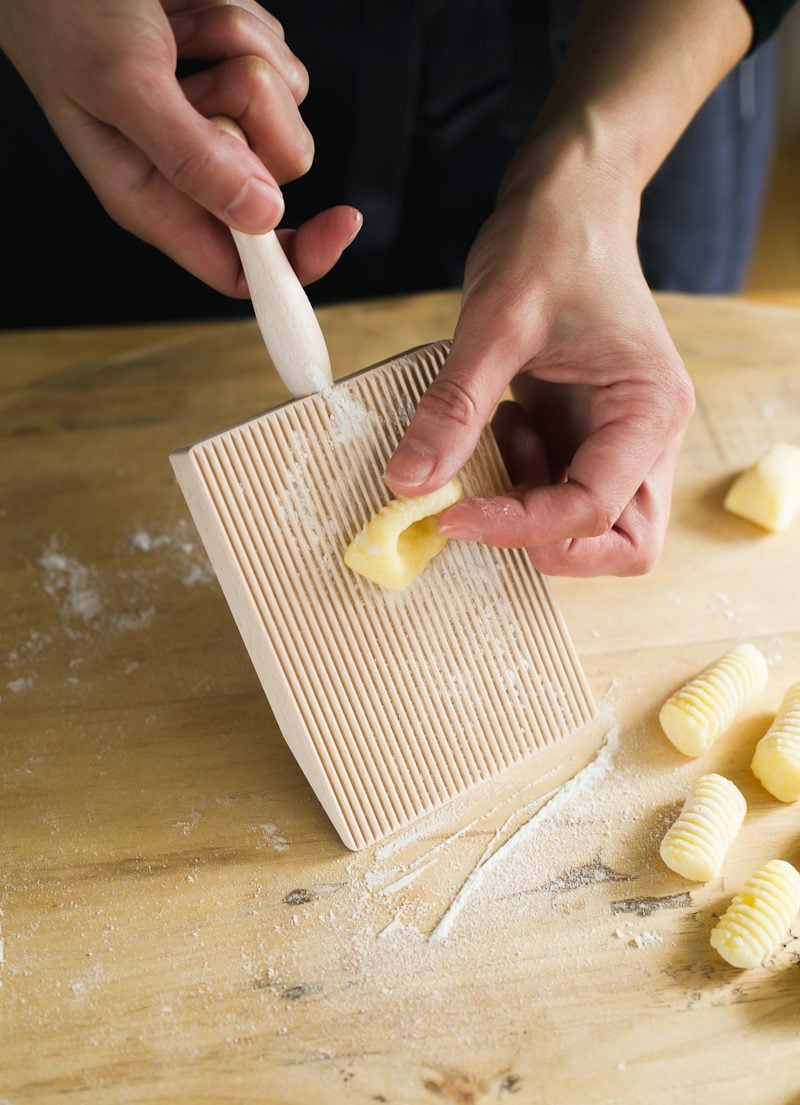
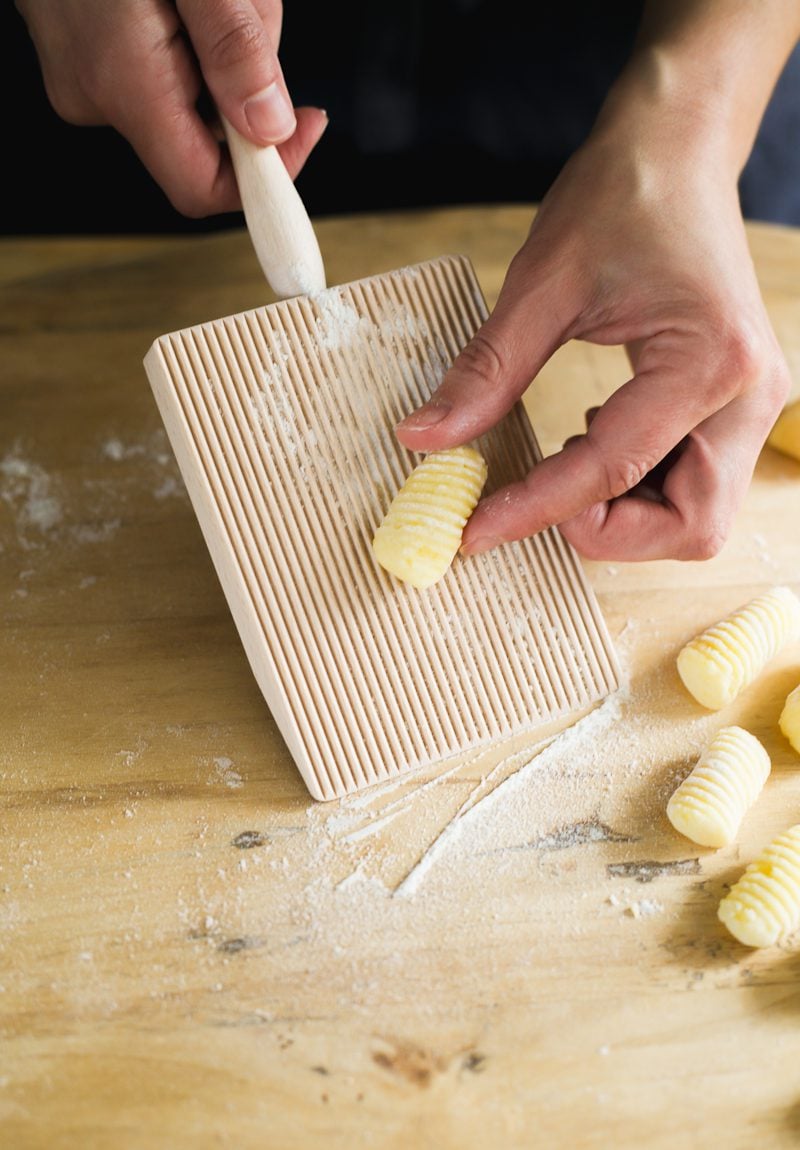
Make Ridges (optional)
At this point, if you have a gnocchi board, roll to create ridges. This creates interesting texture which traps the sauce. It’s like penne rigate (with ridges) vs. regular penne (smooth). You can also use the tines of a fork to create ridges; however I think using the board is easier.
- Holding the board on a slight angle, gently press the gnocchi into the board with your thumb. In one forward motion, use your thumb to gently roll the gnocchi down the board. Then flip it over. Repeat to roll the rest of the gnocchi.
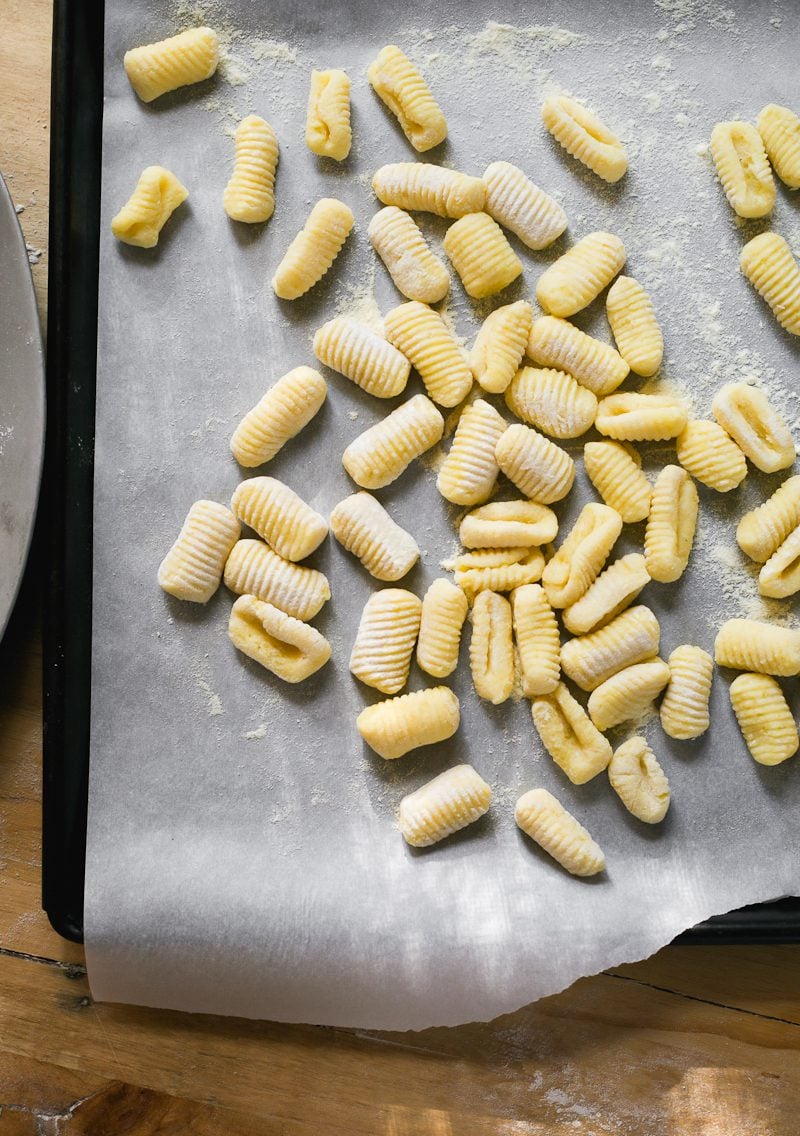
Ok, So What’s Next?
If you’re going to cook the gnocchi now, have your sauce simmering and ready to go. They take about 1 minute to cook, tops. This is not the time to scramble about (I usually have frozen sauce on standby for this very reason). My classic pesto sauce, Ragù Bolognese and this pomodoro sauce are excellent starting points. See below for more gnocchi sauce options.
Best Sauce for Homemade Gnocchi
- Ragù Bolognese Sauce (sometimes I add peas to this)
- Quick Sicilian-Style Tomato Sauce
- Easy Golden Butter & Sage Pasta Sauce
- Quick Homemade Sausage Ragù
- Authentic Pomodoro Sauce (Fresh or Canned)
- Classic Italian Basil Pesto (Pesto alla Genovese)
- Pesto alla Trapanese (Sicilian Pesto)
How To Cook Gnocchi
Working in batches, drop a few gnocchi into boiling, salted water (this is your test batch). It’s important the water is generously salted, otherwise the gnocchi will taste bland. Cook for 30 seconds to 1 minute. When they float to the top, they’re ready. Transfer via slotted spoon directly into your sauce. Do not use a colander to drain the gnocchi; they are too delicate.
Note: If using frozen gnocchi, there’s no need to defrost them first. Cook straight from frozen. Only add a few frozen gnocchi to the pot at one time; otherwise they will sink to the bottom and stick together.
How To Store Gnocchi
Fresh homemade gnocchi can be stored at room temperature, covered, for 30 minutes to 1 hour. They have a tendency to become sticky if held longer than that; make sure your sheet pan is well dusted in semolina flour. Cover with an inverted sheet pan or a clean kitchen towel. Alternatively, cover with plastic wrap and chill for a few hours.
How To Freeze Gnocchi
Freeze gnocchi in one single layer on a flour dusted sheet pan. Once frozen, transfer to an airtight container (they shouldn’t stick together). Label, date and freeze up to 3 months. To use: cook straight from frozen in batches.
More Traditional Italian Recipes to Try!
- Beginner’s Guide to Fresh Homemade Pasta
- Beginner’s Guide to Fresh Homemade Lasagna Noodles
- Beginner’s Guide to Fresh Homemade Ravioli
- How to Make Perfect Pappardelle Pasta
- Fresh Spinach Pasta Dough
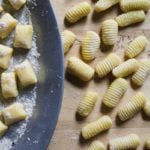
Beginner’s Guide to Fresh Homemade Gnocchi
- Prep Time: 45 minutes
- Cook Time: 1 minutes
- Total Time: 46 minutes
- Yield: Serves 4
- Category: Homemade Gnocchi
- Method: Stove-top
- Cuisine: Italian
- Diet: Vegetarian
Description
An easy recipe for light and fluffy homemade potato gnocchi. My secret is Yukon gold potatoes, egg yolk (only) and fine milled Tipo 00 flour for best texture and flavor.
Ingredients
- 450 g (1 lb) Yukon gold (or regular gold) potatoes.
- 1 egg yolk
- 1/4 tsp. fine sea salt
- 85 g Tipo 00 flour (or all purpose flour), plus more as needed
- Semolina or rice flour, for dusting
Tips, Notes & Substitutions:
- For smooth, lump free gnocchi you will need a potato ricer for this recipe. Alternatively, use a food mill of mash the potatoes gently with a fork.
- If you cannot find Yukon gold potatoes, any “gold” variety potato will do. You’re looking for a potato that’s semi waxy, creamy and dense. Floury potatoes, such as Idaho potatoes and Russets retain too much moisture and can be too mealy when cooked.
- Think ahead: if you’re going to cook the gnocchi right away, have your sauce simmering and ready to go. Gnocchi are quick to cook; you’ll transfer the little dumplings via slotted spoon directly into the sauce. Otherwise, see the storage options below.
Instructions
- Boil the potatoes, skin on, until tender about 25 minutes. Pierce with a small knife to check for doneness; if slips out with ease, the potatoes are ready. Note: if your potatoes are old or dry, they will take longer to cook. Drain the potatoes and dry well (moisture and gnocchi do not get a long).
- Once cool enough to handle, but still warm: peel off the skin and then pass through a potato ricer over a large, wide bowl. Allow the steam to evaporate. Tip: The potatoes shouldn’t be hot or cold- warm to the touch is crucial for ingredient incorporation. You won’t need extra flour later on if the dough is sticky.
- Form a well in the center of the potatoes. Add the egg yolk, salt and sprinkle some of the flour on top. Gently mix a few times with a fork to combine, gradually adding the rest of the flour as you go. Once the dough starts to stick together (but is not yet a ball) stop. You’re going to finish by hand.
- With your hands, gently bring the dough together to form a cohesive ball. You’re basically smushing the dough together. You do not need to “work” or knead the dough (this is not pasta or bread dough). The texture should feel soft, warm and smooth- like a giant mashed potato ball. If it’s notably sticky, add a sprinkle of flour. Cover with an upturned bowl and let rest for 10 minutes (do not skip this step- the dough will be easier to roll out).
- Cut the dough ball into 4 equal pieces. Roll one piece into a 10-12 inch (25-30 cm) log. Cut across into 20-22 gnocchi, about 1/2-inch (1.25 cm) in size to create little “pillows.”Transfer to a sheet pan dusted in rice flour or semolina flour to prevent sticking. Repeat with the remaining pieces.
- (Optional Step) If you have a gnocchi board, roll each piece to create ridges. Holding the board on a slight angle, gently press the gnocchi into the board with your thumb. In one forward motion, use your thumb to gently roll the gnocchi down the board. Then flip it over. Repeat to roll the rest of the gnocchi.
How to Cook Gnocchi: Working in batches, drop a few gnocchi into boiling, salted water. This is your test batch. It’s important the water is generously salted, otherwise the gnocchi will taste bland. Cook for 30 seconds to 1 minute (when they float to the top, they’re ready). Transfer via slotted spoon directly into your sauce. Do not use a colander to drain the gnocchi; they are too delicate.
How to Store Gnocchi: Fresh homemade gnocchi can be stored at room temperature, covered, for 30 minutes to 1 hour. They have a tendency to become sticky if held longer than that; make sure your sheet pan is well dusted in semolina flour. Cover with an inverted sheet pan or a clean kitchen towel. Alternatively, cover with plastic wrap and chill for a few hours
How to Freeze Gnocchi: Freeze gnocchi in one single layer on a flour dusted sheet pan. Once frozen, transfer to an airtight container (they shouldn’t stick together). Label, date and freeze up to 3 months. To use: cook straight from frozen in batches.
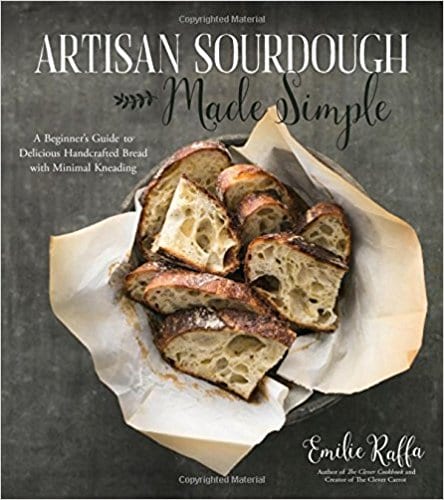

Comments
Aaron says
Amazing recipe. Thank you!!!
kim says
This wasy first time making gnocchi and they came out perfect! Thank you.
Taz says
I accidentally cooked up two pounds of potatoes. So I doubled my recipe. Even the normal batch made a lot. I just kept them pillows. I didn’t not use a gnocchi board.
Very delicate and light.
Carissa Renard says
Do we have to boil the potatoes whole? Mine aren’t fork tender within 25 minutes so I feel like if you’re cooking all 4 whole it’s more like 50 mins till an hour to make sure they’re cooked all the way
Emilie Raffa says
Yes. With the skin on. Timing will definitely vary depending on the size of the potatoes and freshness. So it’s 100% OK if yours took longer than 25 minutes! You want to make sure they are cooked through.
Carissa says
I just made these and they turned out okay, a little softer than I expected and the dough stayed sticky a lot longer than I thought it would so I had to add a bunch more flour.
I heard that russet potatoes are drier so I might try using those next time for gnocchi as that’s what serious eats recommends
Diane says
I made this after making my first sourdough also from your page- both working out perfectly first time! Excellent and straightforward explanations, delicious end results…so look forward to trying more!
Emilie Raffa says
Diane, this is such wonderful feedback. Thank you so much! :)
Lucia says
These turned out fab! I made a brown butter and sage sauce to accompany it. I didn’t have a potato masher or a rice so I used a mesh sieve and it worked great. They had a good amount of chew without being gummy- also used AP flour
Emilie Raffa says
Fantastic. Thanks for sharing your feedback Lucia :)
Phyllis says
My first attmept at making gnocci. Excellent recipe, well explained. Goncci turned out perfect. And I was told yellow potatoes would not work!!!
Amanda says
Excited to try your recipe for homemade gnocchi, especially after my recent attempt that failed spectacularly. do you have any advice on how to add ingredients for flavored gnocchi? Like pumpkin, or tomato basil?
Kay says
This gnocchi turned out so amazingly yummy! I tossed it with fresh sage and butter. I can’t wait to eat my leftovers tomorrow.
Emilie Raffa says
Kay, this is so great to hear! I’m thrilled you like this recipe. I love gnocchi. Special, right?
Thais Guimarães says
I made these and indeed, they tasted and felt like little clouds. The best gnocchi I’ve ever had.
Anthony G. says
I just made these tonight and just used Shoprite brand eastern potatoes and immediately drained them when cooked and tossed them on a cloth to fully absorb the water. Everything else i did exactly as the recipe states and came out amazing. I doubled the recipe to make this and it doubles without any issue.
SaraWerra says
I made these with regular potatoes, and they were divine! I froze half the batch. When I cooked the frozen batch they completely fell apart and essentially became boiled mashed potatoes. Any idea why? Not enough handling? Undercooked potatoes? Wrong proportions? May have used too much potato, but otherwise followed the recipe. Trying again today, because they were so good fresh!
Emilie Raffa says
Hi there! Fantastic! So glad you liked them :) Total bummer about the frozen ones… it’s hard to pinpoint the exact cause without seeing them or touching the dough myself. But usually, when gnocchi fall apart, it’s because there is too much moisture in the dough and/or there’s not enough flour to absorb said moisture. Does that make sense? The moisture comes from the water in the boiled potatoes. Here’s what you can do next time: try adding more flour to the dough, cook the gnocchi per usual, leaving a few off to the side to “test freeze.” Cook the frozen ones later on and see if they hold shape. If the additional flour helped, then you know! Alternatively, try baking your potato instead of boiling it. Or, try par-boiling the gnocchi to set the surface before freezing (then cook from frozen). This is called “poaching.” Hope this helps! If you need additional clarification just let me know!
Sara Werra says
poaching! I’ll try that too. I did make another batch, using more flour. The fresh cooked batch was not as perfect as the previous batch, but still yummy! I froze half, and instead of boiling them, I pan fried them before adding to the sauce…awesome.
I appreciate the feedback. I will look for non russett potatoes for the next batch, that may be the problem also. Sometimes I can get Yukons at my little market here in The Bahamas.
Next up though, is checking your sourdough recipes! I’ve got tons of starter.
Kathy says
Oh my goodness. Gnocchi has been my achilles hill for years – I keep trying, they keep coming out badly to “eh.” I made a batch using the back of a fork and they were very good, but I clunked my way through the process. The second time it all made more sense. I bought one of the gnocchi boards and voila! Perfect. Sauteed some garlic in browned butter, added the gnocchi and toasted them a bit, salt and pepper and a sprinkle of Parmesan on top. Amazing. Thank you :-)
Lou Jenkins says
Hello Emilie
Thank you very much, looking forward to giving it a go.
With regard to the potential problem with moisture, would it be better to bake the potatoes rather than boil them?
Thanks again
Regards
Lou
Emilie Raffa says
Lou, this is an excellent question. You are more than welcome to bake the potatoes, in their jackets, to circumvent a potential problem with moisture. This methods works. Just keep in mind, in comparison to boiling, it will take more time, energy and intensify the potato flavor.
ceebee says
So yummy! Another Tuscan treat, Emilie! Once the readers get hooked on the gnocchi they’ll be ready to try an even more deeply rooted Tuscan version of gnocchi made with all ricotta (strained) in place of potatoes. These days many call the ricotta gnocchi “gnudi” (meaning naked in Italian), since they resemble the inside or filling of a single raviolo, but w/o the pasta “clothing”. Hence the term, gnudi. In our house growing up Nonna called them “malfatti,” which means “badly made,” because no two looked alike.
They are pillowy light in texture and mouthfeel. Nonna always made them with chopped spinach mixed in the dumpling batter/dough, plus the ever necessary nutmeg.
The spinach gnudi together with with your lovely Bolognese sauce is a match made in heaven! The meat in the sauce and the ricotta-spinach dumplings play so nicely together It’s like eating a delicate creation of lasagna, pillow after tasty pillow, minus the pasta sheets. Together they pair so well with a chilled Pino Gris which is a bit more robust for this duo, as opposed to the lighter Pino Grigio. Buon appetito! Keep up the fine recipes, Emilie!
Emilie Raffa says
Oh yes! I am very familiar with gnudi. So light, delicate and utterly delicious. I’m very intrigued about your Nonna’s recipe (not written down, I’m sure!). Did she use homemade ricotta? Or strain the store-bought kind? This is going on my list. You are making me hungry. What a lovely comment- thanks for writing.
ceebee says
Yes, Emilie. Nonna somehow found the time to do most everything in cucina, even cheese making. She made mozzarella and then cooked the leftover whey (ri-cotta) to make the ricotta. I have tried this from memory, as she did not have anything written down! My results have been middling so far, and I think a big part of the problem has been my milk source. Nonna used classic “cream-top” milk delivered to the house daily. I don’t know for certain but I think that it may have also been “raw” as in not pasteurized. When I tried making mozzarella, I used regular homogenized supermarket milk. I tried it with both rennet and also with acid (citric) and both times the curds for the initial mozzarella were very weak and fragile. On doing some research, I found that pasteurization is “okay” but the homogenization alters the proteins important for curd stability. I never did go to the 2nd stage of re-cooking to make the ricotta. So, it’s back to the drawing board for me on this.
Lindy R says
Hello Emilie,
Do you think using a fine shredding blade on a food processor would substitute for the ricer?
Emilie Raffa says
Hi Lindy! Great question. My instinct tells me using a food processor would make the potatoes gummy (the mechanical force is too strong). This would lead to tough and dense gnocchi. However, since you would be using the disc attachment and not the actual blade, over processing might not be an issue. I haven’t tried this myself. But if you experiment, please let me know! Alternatively, use a food mill or mash gently with a fork.
Francesca says
I love these tips, especially using the yolk only. A wonderful lesson. I’m aware that American- Italian pronunciation differs somewhat from Italian. I have never heard the ‘yaw’ sound before. N’YOK EE is how I would go.
Emilie Raffa says
Thank you, Francesca! Using egg yolk only works surprisingly well. I love the subtle color it adds, too (and with the leftover egg white, you can make almond cookies). Re: the pronunciation, I’ve heard it both ways (it’s like tomato/tomahto, lol?) I’ve edited to add the alternative pronunciation.